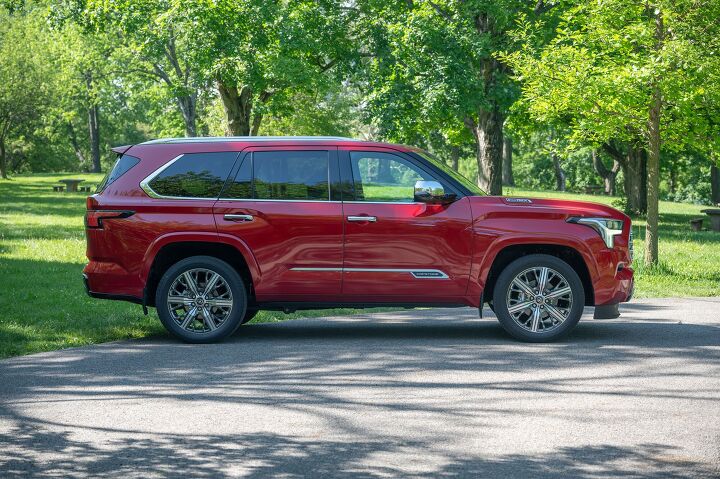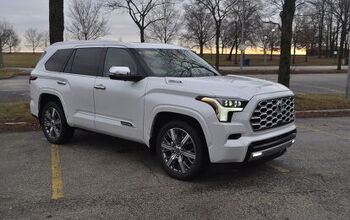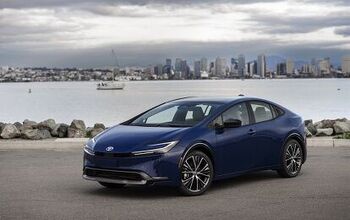2023 Toyota Sequoia Review - A Three-Row Prius?

2023 Toyota Sequoia Capstone 4WD
Toyota wasn’t the first to market a hybrid car here in the U.S. Despite that, the Prius has become the defining hybrid car of the past two decades or so, with the model name occasionally outshining the marque itself. Hybridization has metastasized throughout the Toyota lineup, punctuating nearly every model and segment with electrification.
It only stands to reason that the largest vehicles in a lineup, those vehicles for which fuel economy has never been the sole focus, should be among the last to see battery power. Within full-sized trucks and SUVs, however, there are plenty of gains to be made and plenty of room to stow extra batteries for additional economy and performance.
While the full-sized Tundra offers the choice between a standard turbo V-6 and hybridization, this 2023 Toyota Sequoia is hybrid only. How does it stack up in the real world? Is it a revelation in fuel efficiency, or does it keep you from seeing the redwood forest for the trees?
Whenever I drive a new vehicle, I try to look at it from a few angles. First, I ask myself where it might fit in my life and my driveway. But then I try and consider who the ideal buyer is, and ask how well it fits the needs of that buyer. Maybe it’s all the time I spent in sales, but I know that the marketing and planning departments always have that mythical target buyer in mind when they start to develop a new product.
Perhaps I’m a partial fit for the target demographic of the Sequoia, but I don’t specifically have a need for the size of this thing. When fitted with four-wheel drive, every trim level inches past the magical three-ton mark when empty. It’s 208.1 inches long and 79.6 inches wide, with a 122.0-inch wheelbase. I don’t tow anything regularly, but for those who do, the Sequoia can drag 8,980 pounds of boat, horse, car, or whatever.
For those who do need the capability of this big rig, it’s competitive. The 583 lb-ft of electrically-assisted torque is addictive. Sadly, dipping into the throttle does send the fuel economy reading south, as the 20 mpg combined estimate might be a bit optimistic. My time in the Sequoia yielded readings in the 17 mpg range. That’s no improvement upon what I typically experience in V8-powered domestic rivals. Maybe the big 22-inch wheels fitted to this top-level Capstone trim affect the economy somewhat, though there is no difference in the EPA ratings for lesser trims.
Comfort and ride quality aren’t what one might hope for out of a dreadnought-class SUV, either. Competitors have broadly moved to the independent rear suspension, but the Sequoia persists with the live rear axle borrowed from platform mate Tundra. Midcorner bumps send the hindquarters in a mild shimmy - it’s never uncontrollable, but it isn’t as plush a ride as one finds elsewhere.
The combination of a live axle and hybridization has another downside - rear headroom. The battery is above that axle, and thus right below the third-row seat. While this is a vehicle seemingly meant for hauling mass quantities of human cargo, those of average height and above will find themselves intimately acquainted with the texture of the headliner should they be unlucky enough to pull the short straw boarding position. Materials throughout the interior are quite nice, but that rear row is just a bit too cozy.
My concern with Toyota is they don’t seem to want to be the best with their mainstream vehicles - and that I’m talking about an eighty-thousand-dollar full-size luxury SUV as a mainstream vehicle is frankly absurd, to be honest. It feels as if Toyota is content to let their legendary customer loyalty and fabled reliability continue to feed customers into their showrooms, rather than building fully-realized market-leading vehicles. We know that Toyota has enthusiasts squirreled away within the engineering and product planning teams - witness the crazy GR Corolla I reviewed last month - but it often feels they deliberately hold back on their volume models.
The 2023 Toyota Sequoia is, frankly, more of the same. I have no doubts that they’ll easily sell every one they make. But competitors are building SUVs with fewer compromises, and that’s why I’m disappointed with Toyota’s biggest tree.
[Images: © 2023 Chris Tonn/TTAC.com]
Become a TTAC insider. Get the latest news, features, TTAC takes, and everything else that gets to the truth about cars first by subscribing to our newsletter.

Some enthusiasts say they were born with gasoline in their veins. Chris Tonn, on the other hand, had rust flakes in his eyes nearly since birth. Living in salty Ohio and being hopelessly addicted to vintage British and Japanese steel will do that to you. His work has appeared in eBay Motors, Hagerty, The Truth About Cars, Reader's Digest, AutoGuide, Family Handyman, and Jalopnik. He is a member of the Midwest Automotive Media Association, and he's currently looking for the safety glasses he just set down somewhere.
More by Chris Tonn
Latest Car Reviews
Read moreLatest Product Reviews
Read moreRecent Comments
- CaddyDaddy Start with a good vehicle (avoid anything FCA / European and most GM, they are all Junk). Buy from a private party which allows you to know the former owner. Have the vehicle checked out by a reputable mechanic. Go into the situation with the upper hand of the trade in value of the car. Have the ability to pay on the spot or at you bank immediately with cash or ability to draw on a loan. Millions of cars are out there, the one you are looking at is not a limited commodity. Dealers are a government protected monopoly that only add an unnecessary cost to those too intellectually lazy to do research for a good used car.
- Redapple2 I gave up on Honda. My 09 Accord Vs my 03. The 09s- V 6 had a slight shudder when deactivating cylinders. And the 09 did not have the 03 's electro luminescent gages. And the 09 had the most uncomfortable seats. My brother bought his 3rd and last Honda CRV. Brutal seats after 25 minutes. NOW, We are forever Toyota, Lexus, Subaru people now despite HAVING ACCESS TO gm EMPLOYEE DISCOUNT. Despite having access to the gm employee discount. Man, that is a massive statement. Wow that s bad - Under no circumstances will I have that govna crap.
- Redapple2 Front tag obscured. Rear tag - clear and sharp. Huh?
- Redapple2 I can state what NOT to buy. HK. High theft. Insurance. Unrefined NVH. Rapidly degrading interiors. HK? No way !
- Luke42 Serious answer:Now that I DD an EV, buying an EV to replace my wife’s Honda Civic is in the queue. My wife likes her Honda, she likes Apple CarPlay, and she can’t stand Elon Musk - so Tesla starts the competition with two demerit-points and Honda starts the competition with one merit-point.The Honda Prologue looked like a great candidate until Honda announced that the partnership with GM was a one-off thing and that their future EVs would be designed in-house.Now I’m more inclined toward the Blazer EV, the vehicle on which the Prologue is based. The Blazer EV and the Ultium platform won’t be orphaned by GM any time soon. But then I have to convince my wife she would like it better than her Honda Civic, and that’s a heavy lift because she doesn’t have any reason to be dissatisfied with her current car (I take care of all of the ICE-hassles for her).Since my wife’s Honda Civic is holding up well, since she likes the car, and since I take care of most of the drawbacks of drawbacks of ICE ownership for her, there’s no urgency to replace this vehicle.Honestly, if a paid-off Honda Civic is my wife’s automotive hill to die on, that’s a pretty good place to be - even though I personally have to continue dealing the hassles and expenses of ICE ownership on her behalf.My plan is simply to wait-and-see what Honda does next. Maybe they’ll introduce the perfect EV for her one day, and I’ll just go buy it.











































Comments
Join the conversation
Jumping in here to address the comments about 'the Sequoia persists with the live rear axle borrowed from platform mate Tundra'. Previous gen Sequoia actually went IRS for the 2008 MY straight through to 2022 MY.
I suspect they saw Ford go IRS in the Expedition in 2003 or 2004 and were quick to copy them. Then they saw GM stay with solid axle (and dominate the market) for another decade and decide it wasn't worth the added cost / complexity. Of course GM just went IRS, a couple of years ago, so we will have to wait another 15 year Sequoia product cycle to see if Toyota follows suit :)!
80K for a Toyota that is not named Land Cruiser...